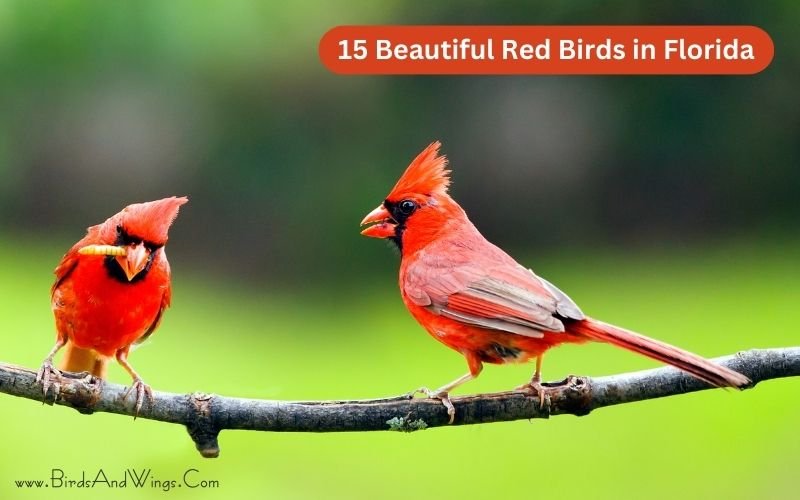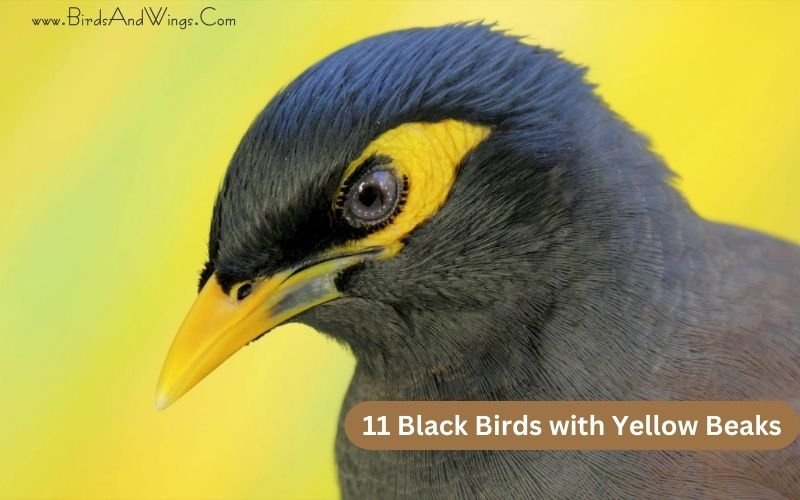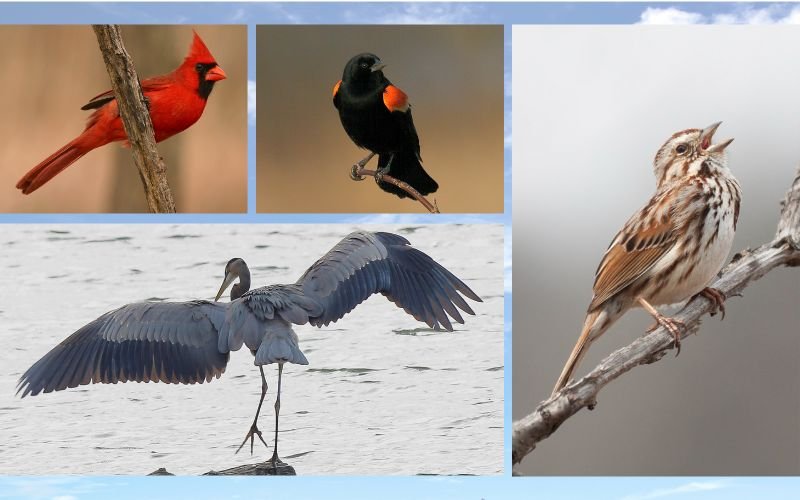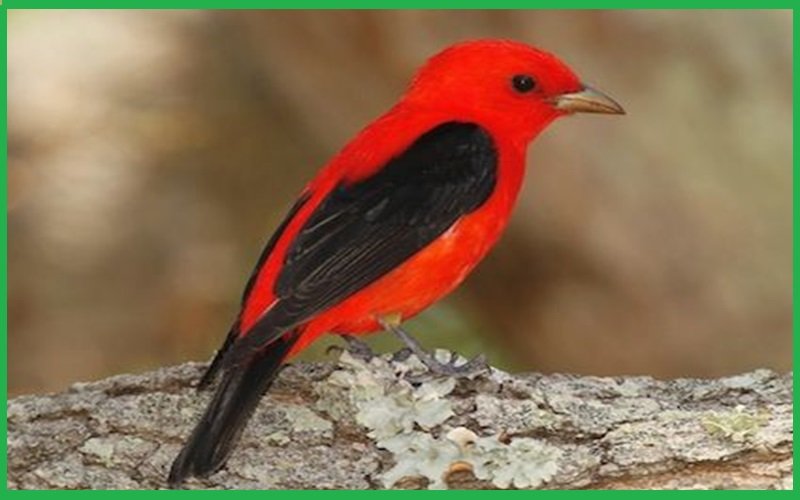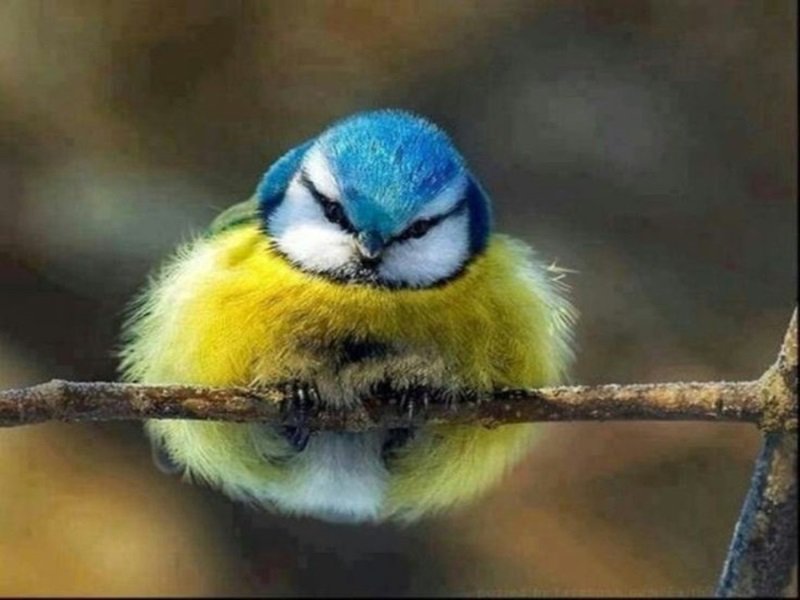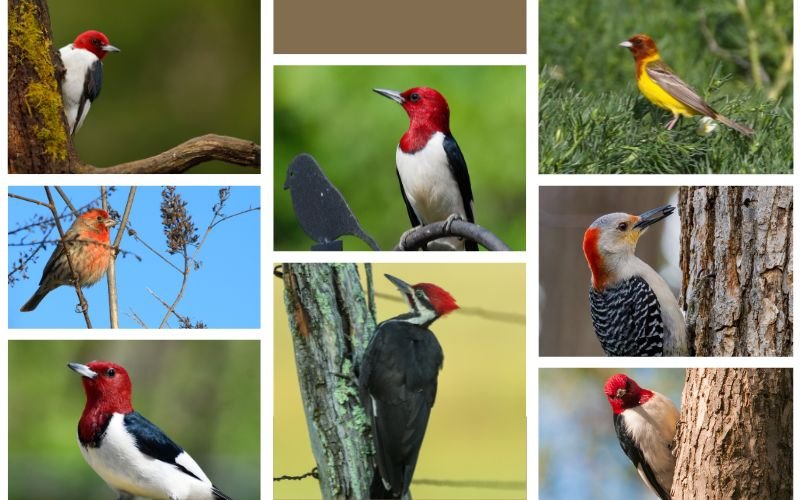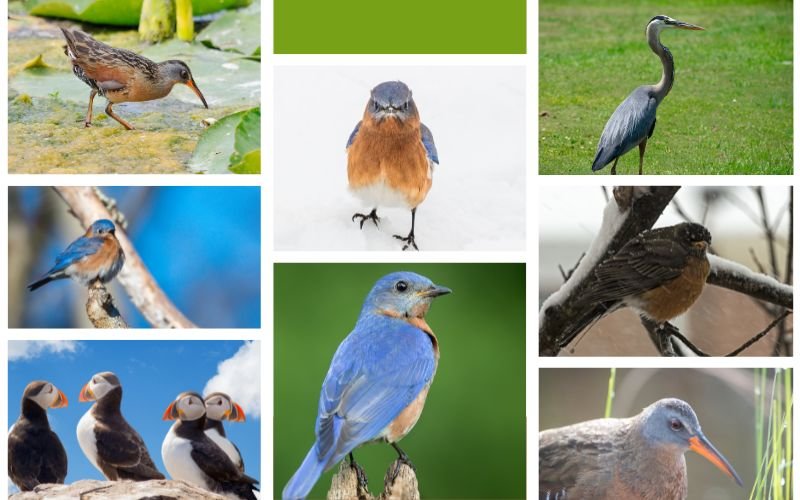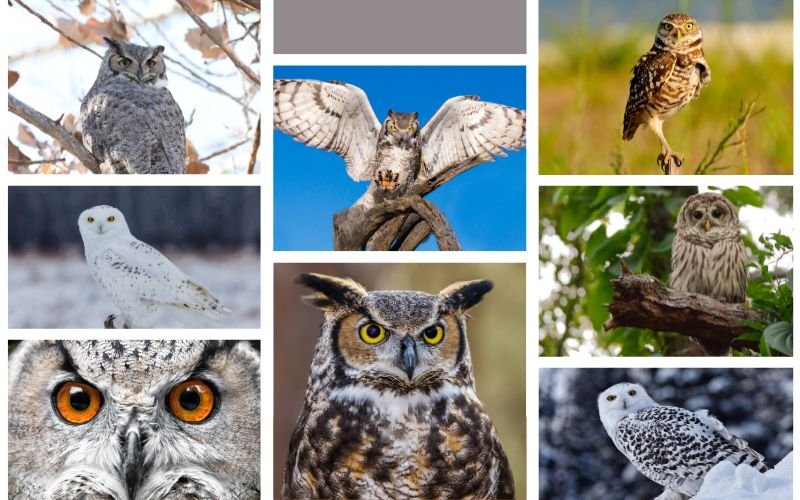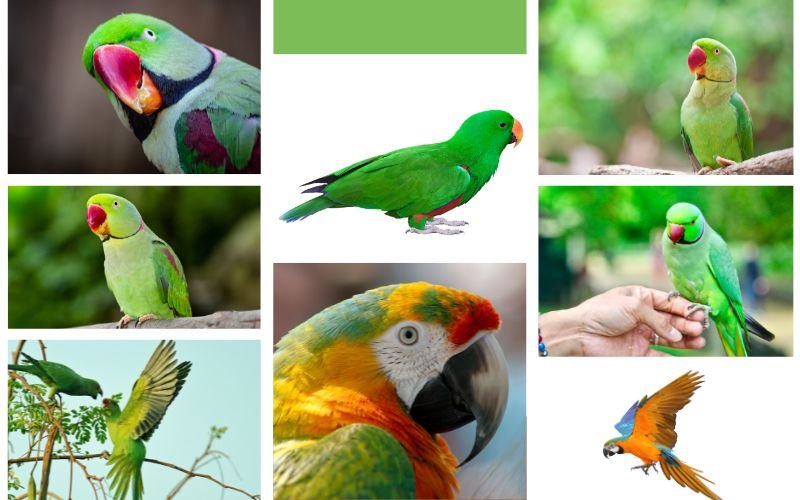Florida City is a place of residence of lots of diverse avian species. As Florida City is enriched with an ecological environment filled with sources and resources for avian species, it has become a recognized place for birds to breed and migrate.
Among them, red birds in Florida are famous and eye-catching birds that attract people, bird enthusiasts, or birders (people who pursue their hobby of birding).
This article is going to explore the top 15 red birds in Florida along with their physical characteristics, such as size, lifespans, food habits, scientific names, native places, distribution, and other facts that help them to survive in nature.
So, let’s delve into the enriched city of Florida and explore the 15 different red avian species.
Top 15 Red Birds in Florida
Florida has become one of the highest cities because of its geographical location, surrounded by many resources that one bird can need. That is why there is diversity in avian species in Florida city.
This section will explore the top 15 red birds in Florida along with their scientific names, size, native places, lifespan, food or diet, and many other characteristics.
1: Northern Cardinal
- Scientific name: Cardinalis cardinalis
- Lifespan: around 15 years
- Native to: Southeastern Canada, Eastern United States
- Size: around 21 to 23 cm
- Food or Diet: seeds, grains, fruits, snails, oats, grasshoppers, etc.
Northern cardinals, also known as red bird, common cardinal, or red cardinal, are the subspecies of the Cardinals family. Their whole body is covered with red plumage with a red crest on their head. Their faces are black around the eyes and nose area; their beaks are also red. Female cardinals are reddish olive in color.
These red cardinals are native across the United States, including Florida, Canada, New Mexico, Texas, Guatemala, and Bermuda. They are fond of open wooded areas, wetlands, parks, and brushy fields for their habitats. Their diet contains 90% of seeds and fruits.
They also eat snails, grasshoppers, flies, insects, etc. They make their pairs for several years, but if one partner dies, they again look for another. During their courtship behavior, they perform display dance and show bonding behavior where male cardinals bring food for the female cardinals and feed their partner from beak to beak.
They build their nests with twigs, strips, grasses, or plant fibers. Female cardinals usually lay 3 to 4 eggs in the nests. Young birds use their vocal sounds to attract their parents when hungry.
In the ancient and historical period, these birds also had some significance of having a spiritual connection with God and the spiritual world that brings good luck to humans.
2: Roseate spoonbill
- Scientific name: Platalea ajaja
- Lifespan: around 10 years
- Native to: South and North America
- Size: 71- 86 cm
- Food or Diet: small fish, frogs, molluscs, newts, insects, crustaceans, etc
The roseate spoonbill is a large bird that is a mixture of subspecies of both Ibis and spoonbill families. Their neck, back, and breasts are white with a greenish head and pink reddish wings.
Their wingspan is around 32 to 38 centimeters. Their beaks or bills are the kind of spoon shape that is flattened downwards. These spoonbill birds are widely scattered in Texas, Florida, the Andes, Caribbean Mexico, and the Gulf of the United States.
All these regions are parts of both South and North America, where they are mostly familiar. During their breeding seasons, they migrate to Florida and the nearby city.
They are fond of mangrove eatery areas and build their nests near watery lakes and rivers. Their feathers then got a deeper pinkish-red color, making them look more stunning.
In the winter season, they make flocks and roam with their flocks. These species also feed in shallow water by moving their beaks side to side. They can also walk through the water to search for their prey.
3: Summer tanager
- Scientific name: Piranga rubra
- Lifespan: around 5 years
- Native to: Central America and South America
- Size: 17 centimeters
- Food or Diet: main food: insects, including beetles, grasshoppers, caterpillars, bugs, flies, spiders, berries and small fruits
Summer tanager is a medium-sized bird famous for its song and melodious voice. Their bodies are covered with red and brown plumage, dark bill, and little black on the wings.
Their wingspan is about 28 to 30 cm, and weight is about 29 grams. The female tanager’s upper body, wings, and tails are olive, and the lower abdomen part is orangish.
These Tanager species are often seen in open wooded places, oaks, and edges of forests from the southern United States, Mexico, Central America, and Northern America.
Summer tanager birds build their nests high up in the trees and cliffs. In Florida, these birds can be seen from April to October.
During their breeding seasons, they migrate to the northern part of the state. Later, they migrated to the Southern parts of the state. The bird feeders can attract these birds with proper food and nutrition.
4: Scarlet Tanager
- Scientific name: Piranga olivacea
- Lifespan: around 10 to 12 years
- Native to: America (North, Central and South)
- Size: 23.5 to 38 cm
- Food or Diet: insects, crustaceans, beetles, caterpillars fruits
The scarlet tanager is a medium-sized bright red bird with black wings and tails. They are familiar mostly in America, including South America, North America, and Central America. Male adults are full bright red, and female birds are olive yellow with gray brown wings.
They are fond of deciduous forests, woodlands, suburban areas, parks, and cemeteries for their habitats. These birds forage high in trees and catch insects while flying from one perch to another.
Their breeding seasons start from the middle of May to early June. Female birds lay four eggs in the nests.
However, occasionally, female birds also give six eggs. Their eggs are light blue, and after 11 to 12 days of incubation period, eggs hatch. Later, the young leave their nests around 9 to 12 days after hatching.
5: Vermilion flycatcher
- Scientific name: Pyrocephalus obscurus
- Lifespan: around 4 to 5 years
- Native to: South America and North America
- Size: 13 to 14 cm
- Food or Diet: insects as flies, grasshoppers, spiders, beetles, etc.
Vermilion flycatchers are small passerine birds related to the flycatcher species family. Their bodies have red and brown plumage on the wings. They also have little crests above their heads, and they raise their crests when needed.
They are mostly familiar in Mexico, the United States, and Central America. They prefer woodlands, open areas, shrub areas, and savanna lands, usually near the water for their habitats.
These flycatchers molt or shed their wings in between 62 to 79 days. This process generally begins in July and lasts till September.
They sing single songs for perching, and their different songs and vocals might refer to their different intentions and events.
These Vermilion flycatchers form small groups or flocks of five or six birds. During their breeding seasons, male birds defend their territory more aggressively and show their aggressiveness by raising their crests and tails to intruders or other birds.
6: Red headed Woodpecker
- Scientific name: Melanerpes erythrocephalus
- Lifespan: maximum longevity 9.9 years
- Native to: North America
- Size: 19 to 25 cm
- Food or Diet: seeds, nuts, berries, fruits, insects etc.
The red-headed woodpecker is a medium size bird with a black back and tails, white breasts, and belly. They have bright red heads and black beaks. These species are mostly common in North America, including southern Canada and East Central United States.
Their diet contains seeds, berries, fruits, small rodents, and the eggs of other birds. They store their food in their tree cavities, and this habit is only found in two to three species of woodpecker, including this redhead woodpecker.
They stuff food into their tree holes or cavities, which helps them to survive throughout the years. These species also make their bond for several breeding seasons with one mate.
After building their nests, these woodpeckers become territorial and try to protect their territory. Sometimes they also destroy other birds’ eggs and their territories as well.
Female birds choose their nesting cavity, and sometimes both males and females drill the tree to make their nesting cavity. However, most of the drilling is done by the male woodpeckers.
7: Painted Bunting
- Scientific name: Passerina ciris
- Lifespan: around 12 years
- Native to: North America
- Size: 12 to 14 cm
- Food or Diet: seeds, grasses, insects, grasshoppers, caterpillars, spider webs, snails etc.
Painted Bunting is a small bird with vibrant color plumage over their body. Their heads are dark blue, their chest lower abdomens are red, and their back and wings are green and black.
Bunting birds are local birds of North America, including New Mexico, Georgia, South Florida, Cuba, Bahamas, Oklahoma, and Arizona. They are seen in Southern Arizona, New Mexico, Texas, and Oklahoma during breeding seasons.
But in winter, they are found in South Florida, Cuba, the Bahamas, and the coasts of Mexico and Central America. These Bunting birds prefer thick shrubbery, woodlands, brushy areas, dense gardens, dense vegetation, and savanna areas for their habitats.
They build their nest usually 3 to 6 feet, a maximum of 12 feet above the ground level. These painted Bunting birds are shy and mostly secretive birds that avoid human contact.
These birds also molt before they start their migratory journey. Some birds tend to do their molting during their mid-migration period.
Sometimes, these birds show agonistic behavior towards other birds and could even kill other birds with such behavior.
8: Red bellied woodpecker
- Scientific name: Melanerpes carolinus
- Lifespan: around 12 years
- Native to: Eastern United states including Florida and Canada
- Size: 22.85 to 26.7 cm
- Food or Diet: beetles, centipedes, spiders, fruits, and other insects
The Red-Bellied woodpecker is a medium size woodpecker with a similar subspecies of the woodpecker family. They are mostly spotted in the eastern United States, including South Florida and North Canada.
Some might confuse them with red-headed woodpeckers however, their red patch on the head, zebra patterns, and black and white stripes in the wings define their identity.
These birds are mostly noisy and create many chur-chur-chur sounds, which shows they are trying to call other groups or pairs to communicate. Sometimes, tap on the hollow trees or aluminum roofs to make a sound.
These woodpeckers can catch their prey or any other insects in flight positions. These red-bellied woodpeckers prefer dead or dry wood for their nesting purposes. Male birds seek the permission of their mates and go for mutual taping for their nesting holes.
9: Rose-breasted grosbeak
- Scientific name: Pheucticus ludovicianus
- Lifespan: around 7.3 years in the wild; 24 years in captivity
- Native to: Central America
- Size: 18 to 22 cm
- Food or Diet: insects, seeds, berries, nectar, wheat, fruits etc.
Rose-breasted grosbeaks are small to medium-sized birds with black heads, backs, tails, and little red on their breasts. These birds are mostly familiar in Central America, the Caribbean, Peru, Venezuela, Colombia, and Costa Rica.
Their preferred habitats are open places and wooded areas. Male birds reach early at their breeding spot before the female birds. After breeding seasons, both birds select and build their nests on tree branches between early May and early June.
They build their nests about 6 to 16.7 meters above ground. Female birds lay 1 to 5 eggs, normally 3 to 4 eggs. Their egg color is greenish to purple brownish color.
These species can live a maximum of 12 years in the wild, and in captivity, their life cycle goes around 24 years.
10: Ruby-throated Hummingbird
- Scientific name: Archilochus colubris
- Lifespan: around 3 to 5 years
- Native to: United States and Central Canada, North America
- Size: 7 to 9 cm
- Food or Diet: flowers, nectars, leaves, insects, barks, spider webs etc.
Ruby-throated Hummingbird is a small subspecies of the hummingbird bird family. Their body is shiny metallic green in the back of their body and grayish-white color in their lower parts along with breast and belly.
They are found in the United States and southeastern Canada during their breeding seasons. In those times, female Hummingbirds constructed their nests in a protected shrub or tree.
Later, when they migrate, they travel across the Gulf of Mexico, the Caribbean, and the eastern United States.
Lastly, in winter, these birds are found in Florida and Mexico. During their courtship rituals, male and female hummingbirds show aggressiveness towards other birds because they defend their territory and nests.
These birds have adaptation flight muscles, which help them to fly effortlessly. All hummingbirds can live around seven years. However, these species can survive about 3 to 5 years in the wild.
11: Pileated Woodpecker
- Scientific name: Dryocopus pileatus
- Lifespan: up to 11 years
- Native to: North America
- Size: 40 to 49 cm
- Food or Diet: fruits, insects, beetles, berries, nuts, ants, spiders, snails etc.
Pileated Woodpecker, medium size woodpecker mostly distributed in North America. They are also found in Canada, the eastern United States, and a few parts of the Pacific coast at different seasonal times.
Their preferred inhabitants are forest areas, heavily wooded parks, and brushy and shrubby areas. These species make large holes by drilling the dead trees or dry trees with their beaks. Even their drilling can divide a small tree in half.
By April, male birds make the hole in a tree and attract their female mates. After that, male and female birds raise the young in the holes. Females incubate for around 12 to 16 days and the egg hatches. Young takes around 25 to 30 days to fly and leave the nests.
When their young leave the nests, both leave the holes, and they do not use the holes in upcoming years. They are not migratory birds, they stay in their holes or cavities and protect their territories for all seasons.
12: Purple Finch
- Scientific name: Haemorhous purpureus
- Lifespan: around 7 years
- Native to: North America
- Size: 12 -16 cm
- Food or Diet: ground vegetation, fruits, seeds, berries and insects
Purple Finch birds are beautiful small birds with red and white plumage over their body. Around the forehead and head parts, the red color is more prominent.
Their eyes are also covered with white lines. These species are native to North America, including Canada, the United States, and the Pacific coasts.
Some birds migrate from northern Canada to the Southern United States and other birds permanently stay in their regions for all the seasons.
They build their nests on a fork of a tree or a horizontal branch of any tree. They mostly eat what they have found on the grounds.
However, their prime food is seeds, berries, sunflowers, millet, and insects. These species try to stay away from human interaction and their contact.
13: Scarlet Ibis
- Scientific name: Eudocimus ruber
- Lifespan: around 16 years
- Native to: Northern America, Caribbean, Brazil, Colombia
- Size: 55 to 63 cm
- Food or Diet: shrimps, shellfish, beetles, bugs, frogs, small snakes, fish, fruits, seeds etc.
Scarlet Ibis are large birds of Ibis species. Their full body is bright red plumage, along with pink legs. Their beaks are comparatively long and slightly curved downwards.
Their weight is about 1.4 kg. These Ibis species are widely distributed around South American Caribbean islands. The Scarlet species are also native to Brazil, Colombia, France, Guiana, Trinidad and Tobago.
They are known for their flocks and community-making ability. Mostly, they roam around, stay with their flocks, and search for food in groups. They make their groups or flocks with 30 or fewer birds.
Sometimes, they mix with other bird groups like storks, egrets, and spoonbill birds. They are migratory birds and can travel for long distances with their selective large flocks.
All these bird groups give companionship to each other for their food and flights. These scarlet ibis birds can survive around 16 years in the wild and 20 years in captivity.
14: Common Redpoll
- Scientific name: Acanthis flammea
- Lifespan: around 2 to 3 years
- Native to: Europe, Asia, North America, Greenland
- Size: 11 -14 cm
- Food or Diet: The main food is seeds and some insects
The common redpoll birds are small birds with red, brown, and white plumage over their body. Males have red patches over their forehead and chest area.
They are familiar with Europe, Asia, northern North America, Greenland, and Iceland. Later, they slightly migrate to southeastern parts in late autumn and northward again in March and April.
They prefer mostly normal forests of pines, spruces, and larches. Their prime food is seeds. However, they eat a few insects. They lay three to four eggs in the nest, and after 11 days, the young fly away.
15: House Finch
- Scientific name: Haemorhous Mexacanus
- Lifespan: around 11 years
- Native to: North America
- Size: 12 to 15 cm
- Food or Diet: seeds, buds, fruits, plants, etc.
House Finch birds, a subspecies of the Finch family, are small nut brownish bodies with a red patch on their face and chin. They are familiar in North America, including New York, Mexico, the southwestern United States, and Canada.
These species prefer semi-open places, urban and suburban places for their habitats. They mainly eat seeds, grains, and sunflowers for their food habits.
These species build their nests in cavities in open buildings, hanging plants, or other cup-shaped outdoor decors. They even use a nest that other birds abandoned.
Female and male birds touch themselves with their bills during their courtship rituals. Sometimes, the male finch will also bring food for his mates and feed them. Even when female birds incubate, male birds feed her at that time.
Finally
In conclusion, these 15 red birds are the top red birds with yellow beaks, which are highly spotted in Florida. As Florida city has a richness of fruitfulness and resources, it has become the most suitable breeding and migration place for birds.
Some birds even stay in all seasons in Florida and protect their territories. Thus, Florida City’s richness and diversity make it the best place for avian species, where they find their suitable breeding season, migration period, and enough food sources.
All these things help them to survive through nature with a distinction. Similarly, Florida is also a home for green birds and bluebirds. Each of the birds has different traits and attributes to nature.

